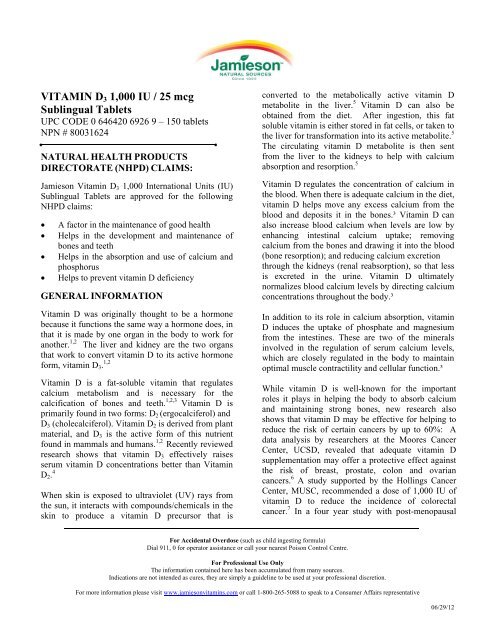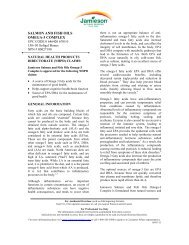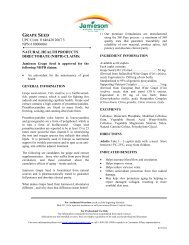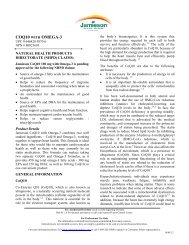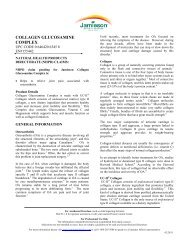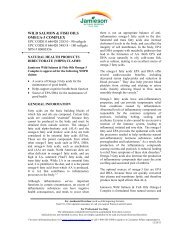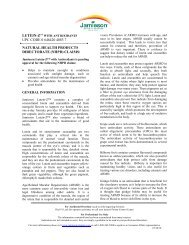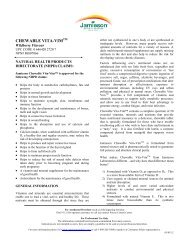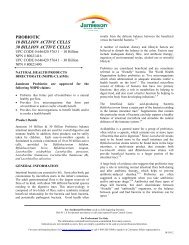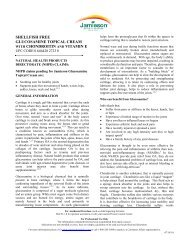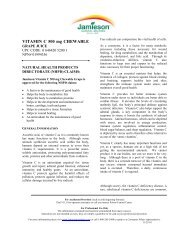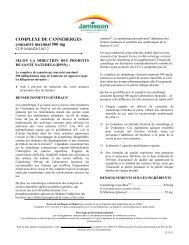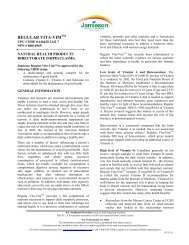VITAMIN D3 1,000 IU / 25 mcg Sublingual Tablets - Jamieson Vitamins
VITAMIN D3 1,000 IU / 25 mcg Sublingual Tablets - Jamieson Vitamins
VITAMIN D3 1,000 IU / 25 mcg Sublingual Tablets - Jamieson Vitamins
Create successful ePaper yourself
Turn your PDF publications into a flip-book with our unique Google optimized e-Paper software.
<strong>VITAMIN</strong> D 3 1,<strong>000</strong> <strong>IU</strong> / <strong>25</strong> <strong>mcg</strong><br />
<strong>Sublingual</strong> <strong>Tablets</strong><br />
UPC CODE 0 646420 6926 9 – 150 tablets<br />
NPN # 80031624<br />
NATURAL HEALTH PRODUCTS<br />
DIRECTORATE (NHPD) CLAIMS:<br />
<strong>Jamieson</strong> Vitamin D 3 1,<strong>000</strong> International Units (<strong>IU</strong>)<br />
<strong>Sublingual</strong> <strong>Tablets</strong> are approved for the following<br />
NHPD claims:<br />
• A factor in the maintenance of good health<br />
• Helps in the development and maintenance of<br />
bones and teeth<br />
• Helps in the absorption and use of calcium and<br />
phosphorus<br />
• Helps to prevent vitamin D deficiency<br />
GENERAL INFORMATION<br />
Vitamin D was originally thought to be a hormone<br />
because it functions the same way a hormone does, in<br />
that it is made by one organ in the body to work for<br />
another. 1,2 The liver and kidney are the two organs<br />
that work to convert vitamin D to its active hormone<br />
form, vitamin D 3 . 1,2<br />
Vitamin D is a fat-soluble vitamin that regulates<br />
calcium metabolism and is necessary for the<br />
calcification of bones and teeth. 1,2,3 Vitamin D is<br />
primarily found in two forms: D 2 (ergocalciferol) and<br />
D 3 (cholecalciferol). Vitamin D 2 is derived from plant<br />
material, and D 3 is the active form of this nutrient<br />
found in mammals and humans. 1,2 Recently reviewed<br />
research shows that vitamin D 3 effectively raises<br />
serum vitamin D concentrations better than Vitamin<br />
D 2 . 4<br />
When skin is exposed to ultraviolet (UV) rays from<br />
the sun, it interacts with compounds/chemicals in the<br />
skin to produce a vitamin D precursor that is<br />
converted to the metabolically active vitamin D<br />
metabolite in the liver. 5 Vitamin D can also be<br />
obtained from the diet. After ingestion, this fat<br />
soluble vitamin is either stored in fat cells, or taken to<br />
the liver for transformation into its active metabolite. 5<br />
The circulating vitamin D metabolite is then sent<br />
from the liver to the kidneys to help with calcium<br />
absorption and resorption. 5<br />
Vitamin D regulates the concentration of calcium in<br />
the blood. When there is adequate calcium in the diet,<br />
vitamin D helps move any excess calcium from the<br />
blood and deposits it in the bones.³ Vitamin D can<br />
also increase blood calcium when levels are low by<br />
enhancing intestinal calcium uptake; removing<br />
calcium from the bones and drawing it into the blood<br />
(bone resorption); and reducing calcium excretion<br />
through the kidneys (renal reabsorption), so that less<br />
is excreted in the urine. Vitamin D ultimately<br />
normalizes blood calcium levels by directing calcium<br />
concentrations throughout the body.³<br />
In addition to its role in calcium absorption, vitamin<br />
D induces the uptake of phosphate and magnesium<br />
from the intestines. These are two of the minerals<br />
involved in the regulation of serum calcium levels,<br />
which are closely regulated in the body to maintain<br />
optimal muscle contractility and cellular function.³<br />
While vitamin D is well-known for the important<br />
roles it plays in helping the body to absorb calcium<br />
and maintaining strong bones, new research also<br />
shows that vitamin D may be effective for helping to<br />
reduce the risk of certain cancers by up to 60%: A<br />
data analysis by researchers at the Moores Cancer<br />
Center, UCSD, revealed that adequate vitamin D<br />
supplementation may offer a protective effect against<br />
the risk of breast, prostate, colon and ovarian<br />
cancers. 6 A study supported by the Hollings Cancer<br />
Center, MUSC, recommended a dose of 1,<strong>000</strong> <strong>IU</strong> of<br />
vitamin D to reduce the incidence of colorectal<br />
cancer. 7 In a four year study with post-menopausal<br />
For Accidental Overdose (such as child ingesting formula)<br />
Dial 911, 0 for operator assistance or call your nearest Poison Control Centre.<br />
For Professional Use Only<br />
The information contained here has been accumulated from many sources.<br />
Indications are not intended as cures, they are simply a guideline to be used at your professional discretion.<br />
For more information please visit www.jamiesonvitamins.com or call 1-800-265-5088 to speak to a Consumer Affairs representative<br />
06/29/12
women, calcium plus vitamin D 3 supplementation was<br />
found to reduce all-cancer incidence. 8<br />
The Canadian Health Measures Survey found that 4%<br />
of Canadians aged 6 to 79 were vitamin D deficient,<br />
and that 2/3 of Canadians are not getting the level of<br />
vitamin D recommended for overall health and<br />
disease prevention. Vitamin D deficiency can occur<br />
if dietary intake is inadequate or exposure to sunlight<br />
is limited, and can result in rickets in children, and<br />
osteomalacia or osteoporosis in adults. 9 Due to the<br />
recent findings of numerous studies, the Canadian<br />
Cancer Society advises that all adults in Canada talk<br />
to their healthcare practitioner about supplementing<br />
with 1,<strong>000</strong> <strong>IU</strong> of vitamin D daily during the fall and<br />
winter months. In addition, the Canadian Cancer<br />
Society recommends that people at a higher risk of<br />
having low vitamin D levels – older adults,<br />
individuals with dark skin, those who spend<br />
significant time indoors and those who wear clothing<br />
that covers most of their skin, or are heavy topical<br />
sunblock users – consider taking 1,<strong>000</strong> <strong>IU</strong> of vitamin<br />
D daily all year-round. 10<br />
While a daily dose of 1,<strong>000</strong> <strong>IU</strong> is recommended by<br />
many major health organizations including the<br />
Canadian Cancer Society, Health Canada suggests a<br />
safe upper daily limit of 2,<strong>000</strong> <strong>IU</strong> of vitamin D from<br />
food and supplements. 11<br />
Vitamin D supplements from <strong>Jamieson</strong> Laboratories<br />
are made using only Quali-D. Fully traceable from<br />
farm to finish, Quali-D is the world’s purest<br />
Vitamin D 3 and the same form that the body naturally<br />
produces when skin is exposed to sunlight.<br />
Quali-D is derived from the world’s finest lanolin,<br />
an abundant, rich and renewable source of Vitamin<br />
D. The lanolin is extracted from the sun-drenched<br />
wool of sheep living in the high country of Australia<br />
and New Zealand and then shipped to France, where<br />
it undergoes sophisticated, state-of-the-art processing<br />
to yield an exceptionally pure, crystalline form of<br />
pre-Vitamin D 3 . Exposure to ultraviolet light — the<br />
same mechanism that allows the body to naturally<br />
synthesize Vitamin D — activates the pre-Vitamin D<br />
and converts it to a pharmaceutical-grade Vitamin D 3 .<br />
This premium finished product, known as Quali-D,<br />
is an allergen and GMO-free vitamin D 3 ,<br />
manufactured without any animal testing.<br />
<strong>Jamieson</strong>’s Vitamin D 3 1,<strong>000</strong> <strong>IU</strong> <strong>Sublingual</strong> <strong>Tablets</strong><br />
are formulated from natural sources and are<br />
pharmaceutically tested to guarantee full potency and<br />
absolute clinical purity.<br />
What makes Vitamin D 3 1,<strong>000</strong> <strong>IU</strong> <strong>Sublingual</strong> <strong>Tablets</strong><br />
from <strong>Jamieson</strong> Laboratories different….and why<br />
does this difference mean better?<br />
1) Formulated with Quali-D, the world’s<br />
premium, natural vitamin D 3 . Fully sustainable,<br />
and traceable from farm to finish without animal<br />
testing.<br />
2) Formulated with Vitamin D 3 . This is the same<br />
form that is naturally produced in the body<br />
during exposure to sunlight, and is more<br />
bioavailable than vitamin D 2 . 1,2,4<br />
3) High potency formula – take only one capsule to<br />
meet your daily needs.<br />
4) Ideal for those individuals who prefer not to<br />
chew or swallow tablets.<br />
5) <strong>Sublingual</strong> tablets melt in the mouth, for fast and<br />
effective absorption.<br />
6) Our premium formulations are manufactured<br />
using the 360 Pure process - a minimum of 360<br />
quality tests that guarantee traceability and<br />
reliability of raw material, product safety, full<br />
potency and absolute clinical purity.<br />
For Accidental Overdose (such as child ingesting formula)<br />
Dial 911, 0 for operator assistance or call your nearest Poison Control Centre.<br />
For Professional Use Only<br />
The information contained here has been accumulated from many sources.<br />
Indications are not intended as cures, they are simply a guideline to be used at your professional discretion.<br />
For more information please visit www.jamiesonvitamins.com or call 1-800-265-5088 to speak to a Consumer Affairs representative<br />
06/29/12
INGREDIENT INFORMATION<br />
Available as 150 sublingual tablets.<br />
Each tablet contains:<br />
Vitamin D 3 (Cholecalciferol)............<strong>25</strong> <strong>mcg</strong>/1,<strong>000</strong> <strong>IU</strong><br />
EXCIPIENTS<br />
Mannitol, dextrose, cellulose, crospovidone, xylitol,<br />
dicalcium phosphate, calcium carbonate, natural<br />
orange flavour, vegetable stearic acid, silica.<br />
DIRECTIONS<br />
Adults: Dissolve 1 tablet daily on or under tongue.<br />
Store between 15°C-<strong>25</strong>°C away from children.<br />
INDICATED BENEFITS<br />
• Helps in normal development and maintenance of<br />
bones and teeth<br />
• Helps in the absorption and use of calcium and<br />
phosphorus<br />
• Helps prevent vitamin D deficiency<br />
• A factor in the maintenance of good health<br />
WARNINGS AND PRECAUTIONS<br />
None known when taken as directed.<br />
TOXICITY, ADVERSE REACTIONS, AND<br />
SIDE EFFECTS<br />
Do not exceed the recommended dosage. Taking too<br />
much vitamin D can cause non-specific symptoms<br />
such as diarrhea, constipation, headache, poor<br />
appetite, weight loss, nausea, vomiting and extreme<br />
fatigue.<br />
Excess vitamin D can also increase blood levels of<br />
calcium (hypercalcemia), potentially causing<br />
heartbeat irregularities and deposition of calcium and<br />
phosphate in the kidneys and soft tissues (i.e.<br />
muscles).<br />
NUTRIENT INTERACTIONS<br />
Drug Interactions<br />
Anti-coagulant drugs, Calcium Channel Blockers,<br />
Magnesium-containing Antacids, Orlistat.<br />
Nutrient Depletions<br />
Corticosteroids, Anti-Asthmatic Drugs/<br />
Bronchodilators, Anti-cholesterol Drugs/HMG-CoA<br />
Reductase Inhibitors, Anti-tuberculosis drugs,<br />
Histamine (H2) blocking drugs, Progestins.<br />
Supportive Interactions<br />
Vitamin D works with calcium to maintain strong,<br />
healthy bones and teeth.<br />
For Accidental Overdose (such as child ingesting formula)<br />
Dial 911, 0 for operator assistance or call your nearest Poison Control Centre.<br />
For Professional Use Only<br />
The information contained here has been accumulated from many sources.<br />
Indications are not intended as cures, they are simply a guideline to be used at your professional discretion.<br />
For more information please visit www.jamiesonvitamins.com or call 1-800-265-5088 to speak to a Consumer Affairs representative<br />
06/29/12
REFERENCES<br />
1. Armas, L.A., Hollis B.W., Heaney, R.P. (2004).<br />
Vitamin D2 Is Much Less Effective than Vitamin<br />
<strong>D3</strong> in Humans. J Clin Endocrinol &<br />
Metab, 89(11): 5387-5391.<br />
2. Mistretta, V.I., Delanaye, P., Chapelle, J.P.,<br />
Souberbielle, C., Cavalier, E. (2008). Vitamin D 2<br />
or vitamin D 3 ? Rev Med Interne, 29(10):815-20.<br />
3. Shils, M.E., Olson, J.A., Shike, M., Ross, A.C.,<br />
editors. (2006). Modern Nutrition in Health and<br />
Disease, 10 th edition. Philadelphia (PA):<br />
Lippincott Williams and Wilkins.<br />
4. Tripkovic, L., Lambert, H., Hart, K., Smith, C.P.,<br />
Bucca, G., Penson, S., Chope, G., Hypponen, E.,<br />
Berry, J., Vieth, R., Lanham-New, S. (2012).<br />
Comparison of vitamin D2 and vitamin D 3<br />
supplementation in raising serum <strong>25</strong>-<br />
hydroxyvitamin D status: a systematic review and<br />
meta-analysis1–3. AJCN, First published ahead of<br />
print May 2, 2012 as doi:<br />
10.3945/ajcn.111.031070.<br />
5. Holick, M.F. (2007). Vitamin D Deficiency. N<br />
Engl J Med, 357: 266-81.<br />
8. Lappe, J.M., Travers-Gustafson, D., Davies,<br />
K.M., Recker, R.R., Heaney, R.P. (2007).<br />
Vitamin D and calcium supplementation reduces<br />
cancer risk: results of a randomized trial. Am J<br />
Clin Nutr, 85(6): 586-91.<br />
9. Langlois, K., Greene-Finestone, L., Little, J.,<br />
Hidiroglou, N., Susan Whiting, S. (2010) Vitamin<br />
D status of Canadians as measured in the 2007 to<br />
2009 Canadian Health Measures Survey. Statistics<br />
Canada, Catalogue no. 82-003-XPE. Health<br />
Reports, 21(1): 47-55.<br />
10. Canadian Cancer Society. Canadian Cancer<br />
Society announces vitamin D recommendation.<br />
June 8, 2007. Accessed June 29, 2012, at:<br />
http://www.cancer.ca/Canada-wide/About%20us/<br />
Media%20centre/CW-Media%20releases/CW-<br />
2007/Canadian%20Cancer%20Society%20Anno<br />
unces%20Vitamin%20D%20Recommendation.as<br />
px?sc_lang=en<br />
11. Health Canada. Vitamin D and Calcium:<br />
Updated Dietary Reference Intakes. Accessed<br />
June 29, 2012. http://www.hc-sc.gc.ca/fnan/nutrition/vitamin/vita-d-eng.php.<br />
6. Garland, C.F., Garland, F.C., Gorham, E.D.,<br />
Lipkin, M., Newmark, H., Mohr, S.B., Holick,<br />
M.F. (2006). The role of vitamin D in cancer<br />
prevention. Am J Pub Health, 96(2): <strong>25</strong>2-61.<br />
7. Gorham, E.D., Garland, C.F., Garland, F.C.,<br />
Grant, W.B., Mohr, S.B., Lipkin, M., Newmark,<br />
H.L. Giovannucci, E., Wei, M., Holick, M.F.<br />
(2005). Vitamin D and the prevention of<br />
colorectal cancer. J Steroid Biochem Mol Biol,<br />
97(1-2): 179-194.<br />
For Accidental Overdose (such as child ingesting formula)<br />
Dial 911, 0 for operator assistance or call your nearest Poison Control Centre.<br />
For Professional Use Only<br />
The information contained here has been accumulated from many sources.<br />
Indications are not intended as cures, they are simply a guideline to be used at your professional discretion.<br />
For more information please visit www.jamiesonvitamins.com or call 1-800-265-5088 to speak to a Consumer Affairs representative<br />
06/29/12


